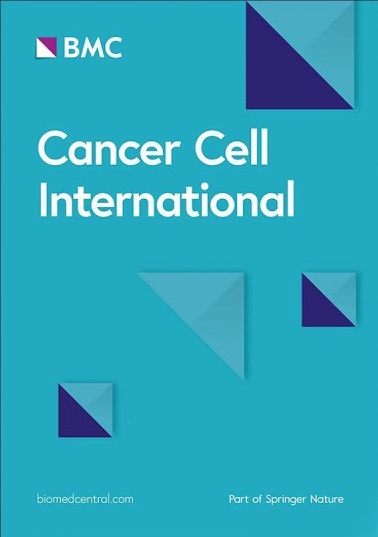Sialylation-associated long non-coding RNA signature predicts the prognosis, tumor microenvironment, and immunotherapy and chemotherapy options in uterine corpus endometrial carcinoma
IF 5.3
2区 医学
Q1 ONCOLOGY
引用次数: 0
Abstract
Sialylation in uterine corpus endometrial carcinoma (UCEC) differs significantly from apoptotic and ferroptosis pathways. It plays a crucial role in cancer progression and immune response modulation. Exploring how sialylation affects tumor behavior and its link with long non-coding RNAs (lncRNAs) may provide new insights into UCEC prognosis and treatment. We obtained RNA transcriptome, clinical, and mutation data of UCEC samples from the TCGA database. Our approach involved developing a risk model based on the co-expression patterns of sialylation genes and lncRNAs. Prognostic lncRNAs were identified through Cox regression and further refined using LASSO analysis. To understand the biological functions and pathways of model-associated differentially expressed genes (MADEGs), we conducted enrichment analyses. We also assessed the immune infiltration status of MADEGs using eight different algorithms, which helped in evaluating the potential for immunotherapy. Additionally, we validated the expression of these lncRNAs in UCEC using cell lines and clinical samples. We developed a UCEC risk model using five sialylation-related lncRNAs (AC004884.2, AC026202.2, LINC01579, LINC00942, SLC16A1-AS1). This model, confirmed through Cox analysis and clinical evaluation, effectively predicted patient outcomes. Survival data analysis across entire cohort, as well as within training and test groups, indicated better survival in low-risk UCEC patients. Enrichment analyses linked MADEGs to sialylation functions and cancer pathways. High-risk patients showed increased responsiveness to immune checkpoint inhibitors (ICIs), as indicated by immunological assessments. Subgroup C2 patients showed superior outcomes and a robust response to immunotherapy and chemotherapy. Notably, LINC01579, LINC00942, and SLC16A1-AS1 were significantly overexpressed in UCEC clinical tumor samples as well as in Ishikawa and HEC-1-B cell lines, compared to the normal groups. This lncRNA signature associated with sialylation could guide prognosis, enhance the understanding of molecular mechanisms, and inform treatment strategies in UCEC. It highlights the potential for the use of ICIs and chemotherapy.Sialylation相关长非编码RNA特征可预测子宫内膜癌的预后、肿瘤微环境以及免疫疗法和化疗方案
子宫内膜癌(UCEC)中的硅氨酰化与凋亡和铁凋亡途径有很大不同。它在癌症进展和免疫反应调节中起着至关重要的作用。探索Sialylation如何影响肿瘤行为及其与长非编码RNA(lncRNA)之间的联系可能会为UCEC的预后和治疗提供新的见解。我们从 TCGA 数据库中获得了 UCEC 样本的 RNA 转录组、临床和突变数据。我们的方法是根据硅烷化基因和lncRNA的共同表达模式建立一个风险模型。通过Cox回归确定了预后性lncRNA,并利用LASSO分析进一步完善了这些lncRNA。为了了解模型相关差异表达基因(MADEGs)的生物学功能和通路,我们进行了富集分析。我们还使用八种不同的算法评估了 MADEG 的免疫浸润状态,这有助于评估免疫疗法的潜力。此外,我们还利用细胞系和临床样本验证了这些 lncRNA 在 UCEC 中的表达。我们利用五个与ialylation相关的lncRNA(AC004884.2、AC026202.2、LINC01579、LINC00942、SLC16A1-AS1)建立了一个UCEC风险模型。经 Cox 分析和临床评估证实,该模型能有效预测患者的预后。对整个队列以及训练组和测试组的生存数据分析显示,低风险 UCEC 患者的生存率更高。富集分析将 MADEGs 与糖基化功能和癌症通路联系起来。免疫学评估显示,高风险患者对免疫检查点抑制剂(ICIs)的反应性增强。C2 亚组患者的疗效更优,对免疫疗法和化疗的反应更强。值得注意的是,与正常组相比,LINC01579、LINC00942和SLC16A1-AS1在UCEC临床肿瘤样本以及石川和HEC-1-B细胞系中显著过表达。这种与ialylation相关的lncRNA特征可以指导UCEC的预后,加深对分子机制的理解,并为治疗策略提供依据。它凸显了使用 ICIs 和化疗的潜力。
本文章由计算机程序翻译,如有差异,请以英文原文为准。
求助全文
约1分钟内获得全文
求助全文
来源期刊

Cancer Cell International
ONCOLOGY-
CiteScore
10.90
自引率
1.70%
发文量
360
审稿时长
1 months
期刊介绍:
Cancer Cell International publishes articles on all aspects of cancer cell biology, originating largely from, but not limited to, work using cell culture techniques.
The journal focuses on novel cancer studies reporting data from biological experiments performed on cells grown in vitro, in two- or three-dimensional systems, and/or in vivo (animal experiments). These types of experiments have provided crucial data in many fields, from cell proliferation and transformation, to epithelial-mesenchymal interaction, to apoptosis, and host immune response to tumors.
Cancer Cell International also considers articles that focus on novel technologies or novel pathways in molecular analysis and on epidemiological studies that may affect patient care, as well as articles reporting translational cancer research studies where in vitro discoveries are bridged to the clinic. As such, the journal is interested in laboratory and animal studies reporting on novel biomarkers of tumor progression and response to therapy and on their applicability to human cancers.
 求助内容:
求助内容: 应助结果提醒方式:
应助结果提醒方式:


